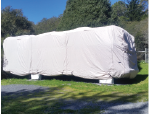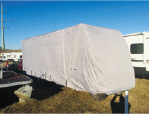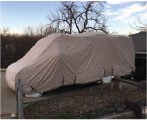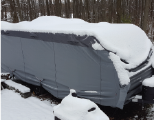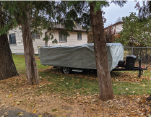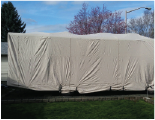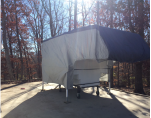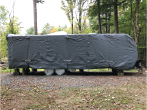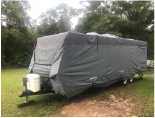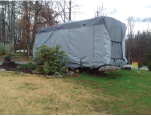
Were you aware that the major Recreational Vehicle (RV) repairs result directly from weather-related damage? Your RV cover is not just a substantial investment you made but for the numerous vacation tours that await you. You should be prepared for traveling in the future when winter approaches by protecting your home. This is especially true if you own a mobile home.
This guide will cover different aspects and strategies for RV winter cover protection. Besides this, you will discover how to narrow down the right cover that properly suits your car. Interestingly, the correct cover can cut many thousands off repair bills. However, the right protection will go a long way to adding more years to your RV's life expectancy.
Let's dive in and learn how to choose the right RV Cover for your boat!
Why You Need an RV Cover in Winters?
Natural Elements: The Silent Destroyers
The winter season and the harshest weather can severely affect recreation vehicles. Without proper protection, your RV faces multiple threats:
- UV Ray Damage: By preventing UV exposure, you avoid spending a lot of money on redoing the facelift of your RV in spring, whose hue would have been further faded and your RV exterior damaged by UV that occurs even in winter.
- Snow and Ice Accumulation: Living in an RV, especially in a snowy climate, may put a great deal of burden on the RV roof tarp and harm the RV.
- Moisture Issues: Moisture causes the building to expand and contract. Water penetrates through these small cracks and causes mold and other interior issues.
- Environmental Debris: Bird droppings, tree sap, and falling leaves are a few of the things that can mar the look of your RV cover and eat deep into the finish.
Financial Benefits of Protection
Where protection does take place, associated financial advantages can be evaluated and compared between differing levels of protection.
This analysis affirms that protecting RVs is a sound financial investment. It could be described as a sort of insurance that does not seek to ‘insure’ against the problem but to prevent it from occurring in the first place. An ideal RV cover costs about $200 to as high as $500. Yet, a single repair session can cost way more than that.
In addition, long-term financial gains can also influence resale value. Mainstream networks are prevalent and continue to possess a value premium on the second-hand market. Which hotshots up to 25% in price when compared with other models lacking such shielding. This premium alone is enough to pay for the initial outlay to invest in quality protection.
Long-term Value Protection
Your RV will last a whole lot longer if you regularly use the best RV covers for winter protection. Properly shielded roof covers for RVs do not degrade as fast and deteriorate over time. Also, their systems are more efficient as well. It translates directly into:
- Aluminum siding provides less annual maintenance costs than vinyl siding.
- Fewer emergency repairs
- The overall efficiency of all the systems
- The opportunity to sell the product at a better value is when the upgrade market comes into play.
The math is simple: If they could just learn to spend a few hundred dollars now on prevention, they could prevent themselves from spending thousands of dollars on repair. If you like, consider that a major repair can cost over five years as a protective measure, and you will quickly realize what is the best option.

Types of RV and Camper Covers: A Complete Guide
Travel Trailer Covers
Travel trailers are essentially towable RVs without self-propulsive facilities. These covers cater to all types of trailers, short or long, and have different structural designs. They provide total coverage in a short-term and long-term storage solution. These are intended to protect your investment from adverse weather and ultraviolet radiation. It is important to protect your travel trailer covers from deterioration by using travel trailer covers.
Class A RV Covers
Class A RV covers are, therefore, RV covers for the largest motorized homes on the current market. These premium covers are designed for luxury motorhomes from 26 to 45 feet in length.
Key features include:
- Stiffened top panels to increase the durability of the panels.
- Materials that are immune to the effect of ultraviolet light to protect paint.
- Huge potential for multiple entry points for ease
- Proper flow of air to control the formation of moisture.
- Adjustable straps and buckles of commercial quality to ensure a firm and proper fit.
Class B RV Covers
These are designed for Class B motorhomes used in van conversions. Class B RV covers are for vehicles ranging from 18 to 34 feet. So, these covers are both functional in design and provide enhanced safeguarding.
Essential features:
- Precise fit for van chassis
- The nearness of some doors, storage, and accesses
- Sturdy yet light fabric and materials
- Enhanced ventilation systems
Class C RV Covers
Class C RV covers are ideal for mid-sized RVs with cab-over designs. They are specifically designed to fit their profile. They provide a broad scope of access while operating with the goal of affordability.
Key characteristics include:
- More envelope around the cab-over part
- Heavy-duty fashion due to corner reinforcements
- Multiple access points
- Custom ventilation placement
Fifth Wheel Trailer Covers
These covers are designed for coupling 5-wheel RV covers and are suitable for units 20 to 46 feet in size. Their design factor considers the special shape and demand associated with fifth-wheel trailers.
Special features include:
- Specially designed front section to produce a perfect fit.
- Enhanced roof protection
- Reinforced corners
- Multiple tie-down points
- Openings that are closed by zip to enhance ease of access
Toy Hauler Trailer Covers
These are intended for sport utility RVs. These high-density toy hauler covers provide added protection for carrying capacity requirements in a durability sense. They afford the most protection while still affording functionality.
Notable features:
- Increased grazing area for cargo doors
- Reinforced rear sections
- Weather-resistant materials
- Secure fitting systems
- Extra support in vulnerable areas
Pop-Up Camper Covers
These pop-up camper covers are intended for use in foldable campers. They have a carrying capacity of between 800 and 2000 pounds. They offer the best of both worlds, a light structure with severe protection and excellent for storing boats in the off-season.
Key attributes:
- Adjustable height options
- Easy installation design
- Compact storage capability
- Weather-resistant materials
- Breathable fabric construction
Truck Camper Covers
Truck camper covers are specifically designed for slide-in pickup truck campers. These are RV types for which specific protection is required. They are intended for different types of truck bed dimensions. Yet, they also guarantee full protection of the truck bed area.
Important features:
- Different types of truck bed dimensions require different kinds of custom truck bedliner solutions.
- Enhanced corner protection
- Easy access to panels
- Secure tie-down systems
- Construction provides shelter from the rain
All the cover types are available in a range of quality and price. So you can meet your exact requirements and needs and still get the right cover that will safeguard your investment.

How to Measure Your RV: The Basics
Knowing the exact size of a cover is the first step toward obtaining the right one. Your RV’s dimensions are its overall length and width, which includes mirror widths and height. Do not forget about additional items of furniture such as a ladder and an air conditioning unit.
Need detailed guidance? Visit our complete RV measurement guide.
Essential Features of Quality RV Covers: What to Look For
Material Quality: The Foundation of Protection
To start with, it is intrinsic to understand that the fundamental aspect of any cover as applied to RV storage is material. Vegetable oil leather enhances longevity protection and the general worth of your investment since items imported are of high grades. Modern RV covers mainly come in two primary materials that offer different properties.
Polypropylene Protection
Polypropylene is also extensively used in RV covers due to its good upstream performance as well as its reasonable cost. Due to its ability to repel water without being too heavy, this synthetic material is ideal for its application. It moves well between extremes in temperature and does not change size all that drastically because of the weather. Most cheap covers incorporate multiple polypropylene layers to boost protection's efficacy.
Polyester Durability
In some of their deluxe models, RV covers are made from polyester material. It also presents higher tear strength and durability than polypropylene fabrics as shown in the table below. In any weather condition, polyester will retain lots of strength, and it possesses high UV protection. Though more expensive, polyester covers typically last at least several seasons longer than cotton ones.
Multi-layer Technology
Modern RV covers meet in several layers to provide the utmost protection. It can be made from a hard exterior to provide a waterproof middle layer and a soft finish layer. The above mixture offers broad protection while at the same time offering durability.
Weather Resistance: Beyond Basic Protection
Water Protection Systems
Knowing the meaning of water resistance is essential and useful when thinking about the safety of an RV. The ‘‘waterproof’’ covers keep water away from the mass in most circumstances, allowing penetration in the sturdiest of rains only. Some protect the device from water completely but may compromise the ratings for breathability. Ideally, the best covers incorporate aspects of both treatments and coatings in order to enjoy the best protection.
UV Shield Technology
The UV protection ratings show the extent to which a given cover can protect against harm from the sun. Available covers have UPF of 50+ meaning the fabric provides protection from UV rays. These features protect the paint from fading off and seals made from rubber from wearing off as well as plastics used inside the car. Sun exposure won't reduce the protection level of covers with UV-stable dyes.
Ventilation: The Breathing Factor
This will help to avoid the accumulation of moisture under your covering especially in rainy seasons, molding and mildew will develop. For ventilation, some RV covers have several vents designed to provide RV airflow.
Built-in Venting Systems
In today’s models, the vents are strategically located in covers in a desire to create a circulation system. These vents usually have mesh screens for blocking debris and allowing moisture to escape. Some covers have vents that you can regulate. So that you can open them where the weather is hot or close them where the weather is cool.
Breathable Fabric Technology
Composite coatings enable water to evaporate and stop rain and snow. By using nanoscale holes, water vapor can enter while massive water droplets cannot.
Securing Systems: Staying in Place
Straps and Buckles
Its secure system is strong enough to keep your cover firmly in place when driving in poor weather conditions. A recovery harness element boasts a quality cover with reinforced straps complete with quick-release buckles. The straps on this should be adjustable so that it fits any RV, no matter how big or small.
Corner Protection
Corners are elastic to hold a tight fit to increase protection while the underside cannot trap wind under the cover. Corners should have added strength to avoid separation at stress points. Some covers also have corner weights to have that extra protection from strong winds as well.
Wind Protection Features
Advanced wind protection includes:
- Tension panels that prevent billowing
- Reinforced strap attachment points
- Additional mid-section secure points
- Built-in tension adjusters
The best RV covers incorporate all these aspects to come up with complete RV covers. Consider your climate and storage environment when shopping for food processing equipment. Note that any high-quality features are worth investing in now to prevent high costs for their repair later.
Installation Challenges
There is a lot to think about when putting up an RV cover. You'll need:
- Climb onto the RV roof safely
- Blue light flickered from the antennas and vents
- Manage large fabric sections
- Work with secure mechanisms
The bigger your Recreational Vehicle (RV), the more complex the installation process will be. Many owners omit covers altogether because of the installation requirements. However, with the correct methods and the help of a partner, the procedure is not as overwhelming.
Here’s the installation video for you. Have a look at it.

Common Mistakes to Avoid When Buying and Installing RV Covers
Selection Errors: Making the Right Choice
Many RV owners commit severe errors when purchasing their RV covers. These are the things that most people get wrong: Selecting a cover that is much smaller than the cushion in an attempt to stretch it and maybe even lead to tearing. Consistently associated is the last mistake of choosing a location based on the cheapest or lowest instead of the appropriate features, such as UV protection and the necessity of ventilation systems.
Other selection mistakes include:
- One of the common mistakes that people make when selecting material types to use concerning their climate is:
- Measurement without including accessories included in the RV
- The choice of covers excludes the necessary ventilation options
- Purchasing a universal cover while custom fits are required
Installation Pitfalls: Getting It Right
However, even with the highest quality of the RV cover, it is not exempted from meeting the consequences of wrong installation. An overlooked slip-up involves placing covers on the wet RV, and this just retains moisture, and thereby, the growth of molds. This is because extended installation time is often followed by attempts to quickly secure the object that is to be installed and premature stoppage of the process may lead to wind damage.
Common installation errors include:
- Rubber, vinyl or fabric – And not washing the outer surface of the RV before covering
- Missing a step when he ought to have fitted corner protectors or wool on the sharp corners and edges
- Installing alone when, in fact, the assistance of others is required
- Missing out on the correct strap placement
- Failure to follow the manufacturer’s recommendations.

Conclusion: Protect Your Investment
Your RV symbolizes a journey and an asset at the same time. Appropriate covering on your RV protects numerous exceptional journeys in the future and preserves the value of the vehicle. Please keep in mind that quality protection always saves money and time today instead of requiring you to pay for replacements tomorrow.
Ready to protect your RV?
National RV Covers provides only the best quality custom-made full RV Cover Solutions for all types and sizes of RV. Visit us today to get the proper cover for your RV for better protection.

.png)
